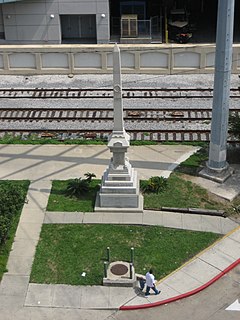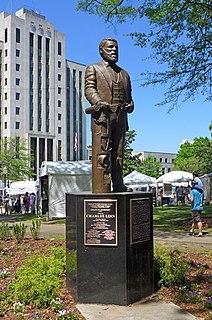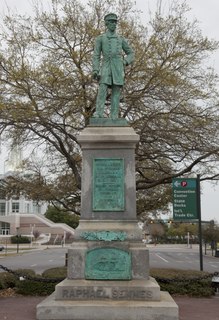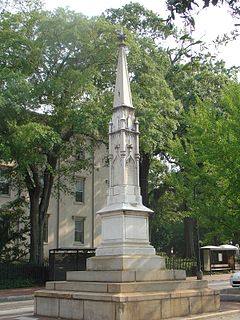See also
- List of monuments and memorials removed during the George Floyd protests
- Statue of Charles Linn, removed around the same time
- Statue of Frank Rizzo, removed around the same time
| Confederate Soldiers and Sailors Monument | |
|---|---|
| United States | |
| For Confederate Soldiers and Sailors | |
| Established | 1905 |
| Removed | June 2, 2020 |
| Location | 33°31′12″N86°48′34″W / 33.52007°N 86.80948°W Coordinates: 33°31′12″N86°48′34″W / 33.52007°N 86.80948°W Linn Park, Birmingham, Alabama |
The Confederate Soldiers and Sailors Monument was a commemorative obelisk that was erected in Linn Park, Birmingham, Alabama in 1905. The monument was dismantled and removed in 2020. [1]
The cornerstone of the Monument plinth was laid during the 1894 Reunion of United Confederate Veterans on Confederate Decoration Day, April 26. [2] and contained a Bible and Confederate flag. [3] The slab of rock was unused for several years, though a surplus artillery piece from the Spanish–American War of 1898 once rested on it. On May 29, 1896, The United Daughters of the Confederacy held a meeting to decide what to do with the plinth and, in 1900, raised money for construction of the obelisk. The 52 foot high monument was completed on April 27, 1905. [4] [5] [6]
In 2017, following widespread concern about the monument being a symbol of historic racism, the Birmingham city council erected a barrier surrounding the memorial, resulting in a lawsuit being brought against it by the state. [7] [8] In January 2019, an Alabama court declared unconstitutional the Alabama Memorial Preservation Act that prohibited "alteration" of the monument. [7] The lower court's decision was reversed in November 2019 by the state Supreme Court, which upheld a fine of $25,000 against the city council. [9] [10]
Following protests in 2020 after the murder of George Floyd, during which protestors damaged and tried to remove the monument, the city council removed the obelisk, leaving only the plinth. [11] [12] The state Attorney General responded by filing a new lawsuit against the city council saying [13] the removal was in violation of the Alabama Memorial Preservation Act of 2017, a law passed specifically to prevent the removal of this monument. It was the most prominent Confederate monument in the state. The Alabama Attorney General filed suit against the city of Birmingham for violating the statute. Mayor Randall Woodfin said the expected $25,000 fine for removing the statue would be much more affordable than the cost of continued unrest in the city. [14] [15] [16]

Monument Avenue is a tree-lined grassy mall dividing the eastbound and westbound traffic in Richmond, Virginia, originally named for its emblematic complex of structures honoring those who fought for the Confederacy during the American Civil War. Between 1900 and 1925, Monument Avenue greatly expanded with architecturally significant houses, churches, and apartment buildings. Four of the bronze statues representing J. E. B. Stuart, Stonewall Jackson, Jefferson Davis and Matthew Fontaine Maury were removed from their memorial pedestals amidst civil unrest in July 2020. The Robert E. Lee monument dedicated in 1890 was removed on September 8, 2021. The last remaining statue on Monument Avenue is the Arthur Ashe Monument, memorializing the African American tennis champion, dedicated in 1996.

The Confederate War Memorial is a 65 foot (20 m)-high monument that pays tribute to soldiers and sailors from Texas who served with the Confederate States of America (CSA) during the American Civil War. The monument was dedicated in 1897, following the laying of its cornerstone the previous year. Originally located in Sullivan Park near downtown Dallas, Texas, United States, the monument was relocated in 1961 to the nearby Pioneer Park Cemetery in the Convention Center District, next to the Dallas Convention Center and Pioneer Plaza.

The Confederate Monument in Murray is a statue located in the northeast corner of the Calloway County Courthouse in Murray, Kentucky. It honors the 800 citizens of the county who served in the Confederate Army during the American Civil War, and is one of several Confederate monuments in Kentucky featuring Robert E. Lee. There is another one in Bardstown KY. Despite recent controversy, the Calloway County Fiscal Court voted to keep the statue on its grounds in July 2020.

The Confederate Monument in Portsmouth, Virginia, was built between 1876 and 1881. It was listed on the National Register of Historic Places (NRHP) in 1997.

The Robert E. Lee Monument was an outdoor bronze equestrian statue of Confederate general Robert E. Lee and his horse Traveller located in Charlottesville, Virginia's Market Street Park in the Charlottesville and Albemarle County Courthouse Historic District. The statue was commissioned in 1917 and dedicated in 1924, and in 1997 was listed on the National Register of Historic Places. It was removed on July 10, 2021.

The Robert E. Lee Monument in Richmond, Virginia, was the first installation on Monument Avenue in 1890, and would ultimately be the last monument removed from the site. Before its removal on September 8, 2021, the monument honored Confederate Civil War General Robert E. Lee, depicted on a horse atop a large marble base that stood over 60 feet tall. Constructed in France and shipped to Virginia, it remained the largest installation on Monument Avenue for over a century; it was first listed on the National Register of Historic Places in 2007 and the Virginia Landmarks Register in 2006.

Steve Marshall is an American lawyer serving as the 48th attorney general of Alabama, having been appointed in February 2017 by Governor Robert J. Bentley to fill the vacancy created by previous attorney general Luther Strange's appointment to the United States Senate. He was elected to a full term in 2018, and is running for re-election in 2022. He previously served as district attorney in Marshall County for 16 years.

The Battle of Liberty Place Monument is a stone obelisk on an inscribed plinth, formerly on display in New Orleans, in the U.S. state of Louisiana, commemorating the "Battle of Liberty Place", an 1874 attempt by Democratic White League paramilitary organizations to take control of the government of Louisiana from its Reconstruction Era Republican leadership after a disputed gubernatorial election.
The Alabama Memorial Preservation Act of 2017 is an act of law in the U.S. state of Alabama which requires local governments to obtain state permission before moving or renaming historically significant buildings and monuments that date back 40 years or longer.
Since the 1960s, many municipalities in the United States have removed monuments and memorials on public property dedicated to the Confederate States of America, and some, such as Silent Sam in North Carolina, have been torn down by protestors. The momentum to remove Confederate memorials increased dramatically following high-profile incidents including the Charleston church shooting (2015), the Unite the Right rally (2017), and the murder of George Floyd (2020). The removals have been driven by historical analysis that the monuments express and re-enforce white supremacy; memorialize an unrecognized, treasonous government, the Confederacy, whose founding principle was the perpetuation and expansion of slavery; and that the presence of these Confederate memorials over a hundred years after the defeat of the Confederacy continues to disenfranchise and alienate African Americans.
The Charlottesville historic monument controversy is the public discussion on how Charlottesville should respond to protesters who complain that various local monuments are racist. The controversy began before 2016 when protest groups in the community asked the city council for the local removal of Confederate monuments and memorials. Other monuments became part of the controversy, including those of Thomas Jefferson because of his ownership of slaves and those of Lewis and Clark for their advocacy of white colonists over Native Americans.

Richmond, Virginia, experienced a series of protests in the wake of the murder of George Floyd. Richmond was the first city in the Southeastern United States to see rioting following Floyd's murder. Richmond, formerly the capital of the short-lived Confederate States of America, saw much arson and vandalism to monuments connected with that polity, particularly along Monument Avenue.

Linn Park is a seven-acre (2.8 ha) urban park in the centre of Birmingham, Alabama. It is overlooked by Birmingham City Hall. Formerly known as Capitol Park, Woodrow Wilson Park, and Central Park, the park was renamed after Confederate naval officer and businessman Charles Linn in the 1980s.
This is a list of George Floyd protests in Alabama, United States. Protests occurred in fourteen various communities in the state.

A statue of Charles Linn was previously installed in Birmingham, Alabama's Linn Park, in the United States. The statue was erected in 2012 and toppled in 2020.

A statue of the Confederate naval officer Raphael Semmes has been on display in Mobile, Alabama, since June 1900. It was removed on 5 June 2020 during the George Floyd protests.

The Athens Confederate Monument is a Confederate memorial that was formerly located in the median strip of Broad Street in the Downtown Local Historic District of Athens, Georgia, United States. It is a Carrara marble obelisk mounted on a granite foundation engraved with names of the city's soldiers who were killed during the American Civil War. It has been dismantled and is in the process of being re-erected in a location near Barber Creek.
More than 20,000 visitors were in Birmingham in attendance upon the fourth annual re-union of the United Confederate Veterans, which convened here to-day. To-morrow, Decoration Day, will be observed in an appropriate manner. The cornerstone of a Confederate monument to be erected by Camp Clayton Sons of Veterans will be laid.